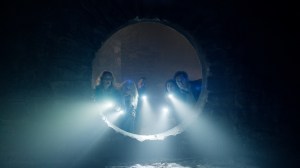Starring Judy Garland as the definitive movie version of Dorothy, 1939’s The Wizard of Oz is a beloved classic that pushed the boundaries of musicals in Hollywood. However, the movie’s production harbors a deadly secret, as The Wizard of Oz extensively used a fatal substance to make its scenes look better.
Videos by ComicBook.com
The Deadly Snow of Oz
The Wizard of Oz is filled with memorable images that would become part of pop culture for generations. Among them, there’s the iconic poppy field sequence, where Glinda the Good Witch (Billie Burke) counters the Wicked Witch’s (Margaret Hamilton) sleep spell. While the snow falling in the field is a marvelous sight, its crafting exposed the cast to significant health risks. That’s because the production used 100% industrial-grade chrysotile asbestos for the snow effect.
The “snow” falling onto Dorothy, played by 16-year-old Garland and her companions, was deliberately chosen for its visual similarity to real snow. However, the use of asbestos in the film wasn’t limited to the snow scenes. The Scarecrow’s costume, worn by Ray Bolger, was treated with asbestos-based flame-retardant material due to scenes involving fire. Similarly, Hamilton’s Wicked Witch wielded a broom made entirely of asbestos to ensure safety during the burning sequences. So, while the witch famously melted in the film, her asbestos broom remained intact.
Asbestos was not the only hazard in The Wizard of Oz. Buddy Ebsen, originally cast as the Tin Man, was hospitalized for two weeks after aluminum powder from his makeup poisoned him. His replacement, Jack Haley, developed a severe eye infection from the same toxic substance. As for Hamilton, she suffered severe burns during a pyrotechnic stunt that required six weeks of recovery. The truth is that there were not enough safety regulations for Hollywood studios in the first half of the 20th century, meaning The Wizard of Oz is just one movie among hundreds that put its cast and crew in danger.
Hollywood’s Widespread Asbestos Use

Using asbestos in film productions was commonplace throughout Hollywood’s golden age. Cotton batting was initially the standard material for fake snow, but it was abandoned due to fire risks from hot studio lights. So, throughout the late 1920s and 1930s, artificial snow made from asbestos was marketed under various brand names such as “White Magic,” “Pure White,” and “Snow Drift.” Films like Holiday Inn (1942), Citizen Kane (1941), and White Christmas (1954), all deemed classics, made use of asbestos for their winter scenes.
The industry’s use of asbestos extended beyond snow effects. Major studios used asbestos in soundproofing materials, electrical insulation, and costume departments. Despite early warnings from medical professionals as far back as the 1920s, companies continued to use asbestos in various applications. The material’s versatility and low cost made it too attractive to abandon, even as evidence of its dangers mounted.
The practice only began to decline in the late 1960s when scientific evidence about asbestos dangers became impossible to ignore. However, the damage was already done. Set designers, costume makers, and special effects technicians had been exposed to dangerous levels of the deadly substance for decades. The full impact wouldn’t be known for years, as asbestos-related diseases typically take 20-50 years to develop.
The Deadly Legacy of Asbestos Exposure

When inhaled, asbestos fibers become permanently trapped in the body, leading to lung inflammation, scarring, and genetic damage. The mineral is the only known cause of mesothelioma, a rare and aggressive cancer that typically develops decades after exposure. Between 700 and 800 people are diagnosed with mesothelioma annually, with an average survival time of only 11 months after diagnosis.
While none of the principal The Wizard of Oz actors are known to have died from asbestos-related causes, other members of the industry were not so lucky. For instance, Ronald Sharpe, a painter on the set of Goldfinger, died from mesothelioma at age 59 due to exposure from asbestos boards used in set construction. Actor Paul Gleason, famous for The Breakfast Club, passed away just three weeks after his diagnosis. Ed Lauter, who appeared in numerous classics, died from mesothelioma in 2013, with his family filing a lawsuit against several movie studios. In 2021, Star Wars prequel actress Trisha Noble also succumbed to the same disease.
The fact that asbestos-related deaths are still occurring shows how damaging the widespread use of the substance was. Sadly, it was not only Hollywood that ignored scientific evidence in the name of profit, as asbestos was used in multiple industries, including construction. One thing is for sure: watching the snow fall in classic movies such as The Wizard of Oz hits differently when we are aware of what happened behind the scenes.
The Wizard of Oz is currently available for streaming on MAX.








